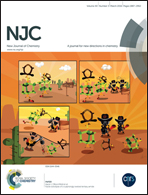DMABI tripod structures with sensing capabilities: synthesis, characterization and fluorescence analysis†
Abstract
We present herein the synthesis, and the structural and spectroscopic analysis of a non-planar tripod-shaped p-(N,N′-dimethylamino)benzyliden-1,3-indandione (DMABI) chromophore. This novel molecule is composed of a Si core with three incorporated arms, each of them contains a 1,3-indandione derivative with an electron donating (−NMe2) group, thus providing fluorescence capabilities. We prepared a DMABI arm by coupling a p-(N,N′-dimethylamino)benzaldehyde (DMAB) tripod substituted molecule with 1,3-indandione via aldol condensation. The structures of DMAB-tripods were confirmed by spectroscopic data and studied by quantum chemical calculations. Fluorescence spectroscopy was used for optical characterization. Quantum yields and the corresponding lifetimes reveal typical characteristics of conjugated derivatives. Finally, we monitored the enhancement in fluorescence intensity of compound 1 in the presence of 4-chloro-2,6-dinitroaniline (4CDNA) in the range between 0 and 20 mg L−1. We justify this enhancement by calculated energies and the distribution of the HOMO and the LUMO for DMABI-tripod and 4CDNA.


 Please wait while we load your content...
Please wait while we load your content...